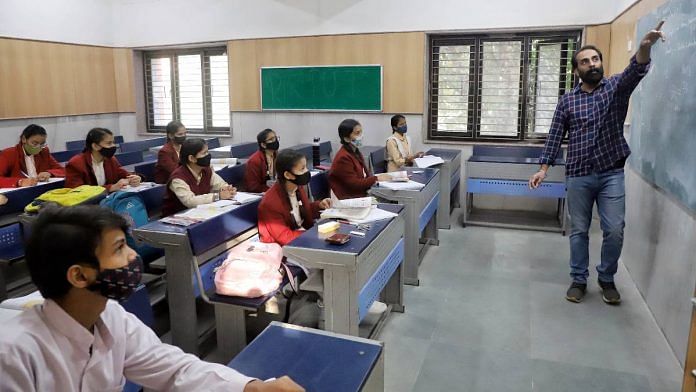New Delhi: Our history books should be continually updated, and account for post Independence history as well, a parliamentary committee said in its recommendations to the government.
Knowledge from the four Vedas — Sama Veda, Yajur Veda, Atharva Veda and Rig Veda — and the Bhagavad Gita should also be part of the syllabus, it said. Parts from Agam Literature (scriptures from Jainism, including preachings from Lord Mahavir) should be included too, the panel said.
The parliamentary standing committee on education, women, children, youth and sports headed by Vinay Sahasrabuddhe made the recommendation in its report titled ‘Reforms in context and design of schools textbooks‘. It was tabled in the Rajya Sabha Tuesday.
“Our history textbooks should be continually updated, and account for post-1947 history as well. In addition, an option of conducting review of National Curricular Framework at regular intervals should be kept,” it said.
The committee added that “NCERT should take a relook at the guidelines for the writing of history textbooks so that equal weightage and importance is given to the various eras, periods and events….”
Also read: Revise textbooks with ‘distorted history’, they glorify Mughals — ex-NCERT head to House panel
Cholas, Chalukyas, Vijaynagar
The panel also recommended the teaching of various past Indian empires across the country that has been, according to the panel, under-represented till now.
The report said it was observed that National Council for Educational Research and Training (NCERT) books do not properly cover some of the great Indian empires, like that of Vikramaditya, the Cholas, the Chalukyas, Vijaynagar, Gondwana or that of Travancore and Ahoms of the Northeast.
The committee added, “NCERT and State Council for Educational Research and Training (SCERT) should incorporate the ancient wisdom, knowledge and teachings about life and society from Vedas and other great Indian texts/ books in the school curriculum.”
It recommended studying educational methodologies adopted in universities like Nalanda, Vikramshila and Takshashila.
“Contributions of ancient India in the fields of philosophy, science, mathematics, medicine, ayurveda, epistemology, natural sciences, politics, economy, ethics, linguistics, arts, etc may also be included in the textbooks. Traditional Indian knowledge systems should be linked with modern science and presented in the contemporary context in NCERT textbooks,” the report said.
The committee also said that all books, especially history books, used for supplementary reading, that are not published by government agencies should be in consonance with the NCERT structure so that discrepancies can be avoided.
‘Class-wise common syllabus’
The panel further suggested that the Ministry of Education should explore the possibility of developing a “core class-wise common syllabus for various subjects”, which can be implemented by CBSE, CICSE and various other state education Boards. It will ensure “uniformity in educational standards of school students across the country,” the committee added.
NCERT, meanwhile, informed the committee that it has already undertaken two recent syllabus revisions and included subjects like GST and demonetisation in its books, as well history representing regional and women icons.
In his presentation before the committee, NCERT Director (in-charge) Sridhar Srivastava had informed that the council undertook a review of syllabi and textbooks in 2017-18 and included topics like Swachh Bharat, Digital India, ‘Beti Bachao Beti Padhao’, demonetisation and GST.
In 2018-19, Srivastava had told the panel, contents were added in history textbooks regarding knowledge, traditions and practices of India. Material on Vikram Samvat (the Hindu calendar), metallurgy, Shivaji Maharaj, Paika revolt, Subhash Chandra Bose, Swami Vivekananda, Ranjeet Singh, Rani Avantibai Lodhi and Sri Aurobindo Ghose was also added.
On figures from Indian history included in the syllabus, Srivastava had given the example of Rani Channamma in the Class 8 history textbook. The book — Our Pasts III — describes how, when the British tried to annex the small state of Kitoor (in modern-day Karnataka), Rani Channamma took up arms and led an anti-British resistance movement.
Also featured in the same textbook and in others is Rani Lakshmibai of Jhansi and her role in the 1857 uprising.
“The role of women Bhakti saints like Ammaiyar, Andal, Mirabai also find adequate space in history textbooks. Great historic women have also been represented in the supplementary materials and other subject textbooks such as sociology, prepared by NCERT,” the director was quoted as saying in the report.
“All periods of Indian and world history are covered as per the established historical scholarship in India,” Srivastava had maintained.
(Edited by Saikat Niyogi)
Also read: Thakur Ram Singh — RSS pracharak who built the movement to ‘rewrite’ Indian history






